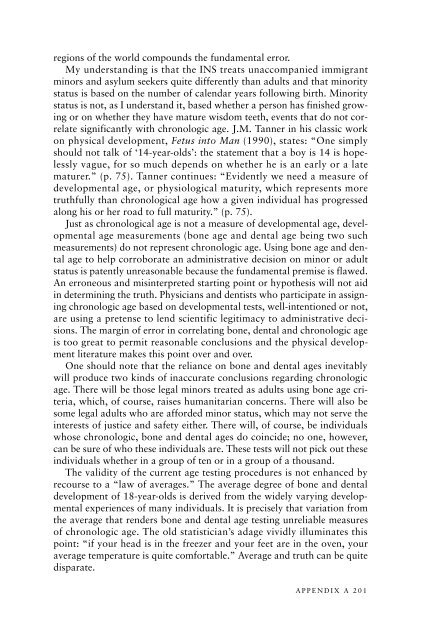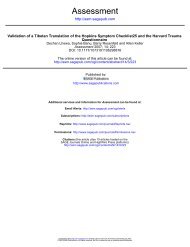From Persecution to Prison - Bellevue/NYU Program for Survivors of ...
From Persecution to Prison - Bellevue/NYU Program for Survivors of ...
From Persecution to Prison - Bellevue/NYU Program for Survivors of ...
You also want an ePaper? Increase the reach of your titles
YUMPU automatically turns print PDFs into web optimized ePapers that Google loves.
egions <strong>of</strong> the world compounds the fundamental error.My understanding is that the INS treats unaccompanied immigrantminors and asylum seekers quite differently than adults and that minoritystatus is based on the number <strong>of</strong> calendar years following birth. Minoritystatus is not, as I understand it, based whether a person has finished growingor on whether they have mature wisdom teeth, events that do not correlatesignificantly with chronologic age. J.M. Tanner in his classic workon physical development, Fetus in<strong>to</strong> Man (1990), states: “One simplyshould not talk <strong>of</strong> ‘14-year-olds’: the statement that a boy is 14 is hopelesslyvague, <strong>for</strong> so much depends on whether he is an early or a latematurer.” (p. 75). Tanner continues: “Evidently we need a measure <strong>of</strong>developmental age, or physiological maturity, which represents moretruthfully than chronological age how a given individual has progressedalong his or her road <strong>to</strong> full maturity.” (p. 75).Just as chronological age is not a measure <strong>of</strong> developmental age, developmentalage measurements (bone age and dental age being two suchmeasurements) do not represent chronologic age. Using bone age and dentalage <strong>to</strong> help corroborate an administrative decision on minor or adultstatus is patently unreasonable because the fundamental premise is flawed.An erroneous and misinterpreted starting point or hypothesis will not aidin determining the truth. Physicians and dentists who participate in assigningchronologic age based on developmental tests, well-intentioned or not,are using a pretense <strong>to</strong> lend scientific legitimacy <strong>to</strong> administrative decisions.The margin <strong>of</strong> error in correlating bone, dental and chronologic ageis <strong>to</strong>o great <strong>to</strong> permit reasonable conclusions and the physical developmentliterature makes this point over and over.One should note that the reliance on bone and dental ages inevitablywill produce two kinds <strong>of</strong> inaccurate conclusions regarding chronologicage. There will be those legal minors treated as adults using bone age criteria,which, <strong>of</strong> course, raises humanitarian concerns. There will also besome legal adults who are af<strong>for</strong>ded minor status, which may not serve theinterests <strong>of</strong> justice and safety either. There will, <strong>of</strong> course, be individualswhose chronologic, bone and dental ages do coincide; no one, however,can be sure <strong>of</strong> who these individuals are. These tests will not pick out theseindividuals whether in a group <strong>of</strong> ten or in a group <strong>of</strong> a thousand.The validity <strong>of</strong> the current age testing procedures is not enhanced byrecourse <strong>to</strong> a “law <strong>of</strong> averages.” The average degree <strong>of</strong> bone and dentaldevelopment <strong>of</strong> 18-year-olds is derived from the widely varying developmentalexperiences <strong>of</strong> many individuals. It is precisely that variation fromthe average that renders bone and dental age testing unreliable measures<strong>of</strong> chronologic age. The old statistician’s adage vividly illuminates thispoint: “if your head is in the freezer and your feet are in the oven, youraverage temperature is quite com<strong>for</strong>table.” Average and truth can be quitedisparate.APPENDIX A 201



